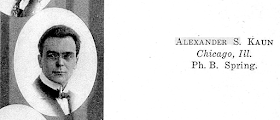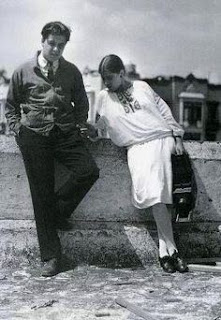Marjorie Eaton, ca. 1935. Photo by Dorothea Lange. Courtesy Oakland Museum of California, Lange Collection.
While researching for my latest essay "
Schindler-Scheyer-Eaton-Ain: A Case Study in Adobe" I discovered a 1932 exhibition at the M. H. de Young Memorial Museum with the all-encompassing title "Horse Show: Horses in Art From Ancient Times to the Present Day" (see catalogue below).
Lloyd LaPage Rollins at 683 Brockhurst, 1932. Photo by Willard Van Dyke. From Group f.64 by Mary Street Alinder, Bloomsbury, New York, 2014, p. 82.
Ambitious museum director Lloyd LaPage Rollins (see above) rounded up and chronologically and subjectively herded 549 items for this omnibus display of horse art throughout the ages. What I found most intriguing about the show was Rollin's tongue-in-cheek inclusions of the work of, and from the collections of, his ever-widening circle of mutual artist friends. Rollins borrowed work from his recent exhibitor Diego Rivera (see below), Marjorie Eaton's close friends Esther Bruton, Maynard Dixon and recent Rivera mural assistant Maxine Albro. Rollins also made a special trip to Carmel where he found work by Edward Weston and his close friends Jean Charlot and Henrietta Shore, Marjorie's former teacher Armin Hansen, William Ritschel and others.
"Zapata" by Diego Rivera, 1932, Courtesy of Museum of Modern Art.
Jean Charlot, 1926. Photo by Edward Weston. From Edward Weston in Mexico, 1923-1926, by Amy Conger, San Francisco Museum of Modern Art, 1983, p. 16. Courtesy Jean Charlot Collection, University of Hawaii. 1981 Copyright Center for Creative Photography, University of Arizona.
I found the most fascinating item in the show to be a tempera painting titled "Horsie" by Weston's close friend Jean Charlot (see above). Weston met and quickly befriended the French transplant Charlot shortly after moving to Mexico with Tina Modotti and his son Chandler in the summer of 1923. They exhibited together at Mexico City's Cafe de Nadie in April of 1924. Intrigued by the local folk art, in September of 1924 Weston began collecting and photographing it and sending it home as gifts for the family and friends. (Conger, p. 16).
Edward Weston by Jean Charlot, 1924. Courtesy Jean Charlot Collection, University of Hawaii.
"Mexican Toys: Bull, Pig, and Horse, and Plate," 1925, Conger, p. 28. San Francisco Museum of Modern Art, Byron Meyer Fund Purchase. 1981 Copyright Center for Creative Photography, University of Arizona.
Weston diarized of the profound impact these simple objects and their still-life arrangements made upon him.
"The evening I spent alone among the ever-fascinating puestos,
purchasing for ridiculously small amounts more animals of clay - a bull, a horse,
a pig (see above) - executed with fine feeling for essential peculiarities of form, or as in
the pig, painted with a keen sense of decoration. ... Always when I go to the puestos (see below) I think of my
little boys, and picture their wide-eyed wonderment and their sure cries of delight
- "O buy this, daddy!" Then, arm-laden, we would walk joyfully home together."
"A Toy Stand in the Alameda" by Tina Modotti, n.d. From Tina Modotto and Edward Weston: The Mexico Years by Sara M. Lowe, Merrell, 2004, p. 100.
"... Still-lifes they
are, and pleasing ones: two fishes and a bird on a silver screen; head of a
horse against my petate (see below). ... The horse is Chinese in feeling - a 7th century porcelain perhaps! Charlot,
seeing it, hied himself at once to the puestos to find another; disappointed,
he playfully attempts to steal mine on every occasion. These still-lifes,
strange to say, are the first I have ever done; and feeling quite sure they
number among my best things, I would comment on how little subject matter counts.
"Caballito de Cuarenta Centavos" or "Horsie," Photo by Edward Weston, 1924. From Edward Weston in Mexico, 1923-1926 by Amy Conger, San Francisco Museum of Modern Art, 1983, p. 16. Also published in Idols Behind Altars, by Anita Brenner, Harcourt, Brace and Co., 1929, p. 113. Courtesy Collection of the California Museum of Photography. UC-Riverside. 1981 Copyright Center for Creative Photography, University of Arizona.
"Diego, Tina tells me, also expressed delight over my
"Fruta de Barro"-Clay Fruit- and "Caballito de Cuarenta Centavos"- Forty-cent
Horse (see above). When Galván saw the title to this picture of my little horse, he said,
"You're Gringo all right; you paid too much. ...
But it is not my little horse any more; Charlot's desire for
it was so great that I could not be comfortably selfish any longer, and sent
the caballito to fresh pastures. Charlot's pleasure was expressed concretely -
he wandered in last night with a water-color sketch under his arm. "To
Edward, my first Boss - Horsie." It was a humorous thing, and I told
Charlot that either he had fed horsie too well on beef-steak or else
"he" had become a wee bit pregnant! The painting was signed
"Fot. Silva", which starts another tale." (The Daybooks of Edward Weston, Vol. 1, Mexico edited by Nancy Newhall, Aperture, 1961, pp. 93-94, 99).
"Horsie" by Jean Charlot, 1924. From Edward Weston's Gifts to His Sister and Other Photographs, Sotheby's 2008. Courtesy Sally Kurtz, Dayton Art Institute.
Weston was still the owner of record for "Horsie" (see above) when it was loaned to Rollins for the 1932 exhibition. Seemingly Rollins had made a trip to Carmel to borrow "Horsie," Henrietta Shore's "White Horse and Goat" and some items from William Ritschel. As was his wont, Weston regifted "Horsie" and a copy of his print that inspired it to his sister for a 1935 "Xmas" present (see gift inscription below).
Verso, (Ibid)
"Clay Bull" by Jean Charlot, 1926. From Avant-Garde Art & Artists in Mexico: Anita Brenner's Journals of the Roaring Twenties by Susannah Joel Glusker, University of Texas Press, 2010, p. 23. Courtesy the Jean Charlot Estate. Photo by Beatriz Diaz.
On December 18, 1925 Charlot's then strong love interest Anita Brenner wrote in her journal of her feelings for Charlot and of buying a clay bull. Evidenced by the above Charlot painting
Brenner perhaps purchased it as a Christmas present for the badly smitten Charlot knowing how much he admired the earlier above "Horsie" Weston gifted him the previous year.
"I bought a very simple beautiful clay bull; of those so much like Chinese sculpture, primitive. White, black, red, yellow and orange. Squat, strong, startling. Very beautiful. A savings bank - thirty centavos." (Brenner, p. 23).
In any event Weston also photographed a clay bull seemingly in Charlot's possession around the same time (see below).
"Bull from the Town of Santa Cruz near Tonala," by Edward Weston, 1926. (Ibid). Copyright 1981 Center for Creative Photography, University Board of Regents. Photo by Michael Nye.
Much of the Mexican folk art Weston photographed during this period was reproduced in Brenner's 1929 paean to Mexico, Idols Behind Altars. The exhaustively researched book included dozens of other photos Brenner specifically commissioned from Weston and Tina Modotti in 1926 along with a compilation of illustrations by Rivera, Orozco, Siqueiros, Merida, Guerrero, Goitia, Posada, Covarrubias and Charlot including his colorful cover design (see below).
Idols Behind Altars, by Anita Brenner, Harcourt, Brace and Co., 1929. Cover art by Jean Charlot. From my collection.
Willard "Spud" Johnson, Taos, 1932. Photo by Will Connell. New Mexico Art Museum Digital Archives.
Rollins's "Horse Show" catalogue "Acknowledgement" list also included from Taos, Miss Marjorie Eaton, Willard "Spud"Johnson (see above), and R. M. Schindler Chicago Palette and Chisel Club mate Walter Ufer. Through a fellow 1922-23 Berkeley classmate and drama performer Eileen Eyre, Rollins met Marjorie Eaton (see below), for whom he held a one-woman show in February of 1932.
(Author's note: Rollins hosted a one-man show for Schindler in April of 1933. For much on the Schindler-Ufer friendship see my ("Edward Weston and Mabel Dodge Luhan Remember D. H. Lawrence and Selected Carmel-Taos Connections").
"Spud" Johnson (standing second from right), painter Marjorie Eaton (seated to far right), sculptor Ruth Cravath (seated three left of Eaton), and Weston-Adams muse Ella Young (seated center just left of Cravath). Santa Fe or Taos ca. 1929-30. Photographer unknown.
Marjorie Eaton, ca. 1935. Photo by Dorothea Lange. Courtesy Oakland Museum of California, Lange Collection.
Miguel Covarrubias cover art for Laughing Horse, issue 16. Spud Johnson and Laughing Horse by Sharyn R. Udall, University of New Mexico Press, Albuquerque,1994. From my collection. (For more on this cover see my "Miguel Covarrubias in Taos, 1929").
Fellow gay Rollins also knew
Spud Johnson and his then lover
Witter Bynner from their Berkeley college days. Johnson was one of the founders of the loosely affiliated radical satirical literary magazine
Laughing Horse (see above) and Bynner was teaching poetry during 1920-21. They both moved to Santa Fe in 1922 where Johnson became Bynner's secretary and continued his involvement editing the by then "scandalous"
Laughing Horse (see below for example). By the time of Rollins's exhibition Johnson had moved to Taos to work for legendary Mabel Dodge Luhan. It was through these connections that Rollins solicited almost 20 "horse" pieces from Spud and a Mexican folk art horse sculpture from Marjorie to include in the show.
(Horse Show, "Acknowledgement"). (Author's note: Bynner made a visit to Miss Burke's School to do a poetry reading during Eaton's senior year there in 1920. As yearbook editor Marjorie reported on his and Vachel Lindsay's April 1920 visits to the Julia Morgan-designed campus. Eaton's close friend Eileen Eyre and Rollins performed together in plays during their senior year in 1923. See much more on this in my "Schindler-Scheyer-Eaton-Ain: A Case Study in Adobe").

"U.C. Instructors Lampooned by 'Laughing Horse'," Oakland Tribune, September 18, 1922, p. 30.
Johnson and much of Taos royalty including Schindler's former Chicago Palette and Chisel Club mates Victor Higgins and Walter Ufer and his 1915 Taos client Doc Martin and artists Oscar Berninghaus, Ward Lockwood, Bert Phillips, Ernest Blumenschein and others were at Marjorie's Taos going away party shortly after Rollin's "Horse Show" ended.
("Society," Albuquerque Journal, January 3 and 12, 1933). After spending much of the previous four years in Taos Eaton was heading off to New York to study at the Art Student's League with Hans Hofmann and Arshile Gorky. By the summer of 1933 she had befriended and was living with Louise Nevelson and was assisting her friend Diego Rivera on his New Worker's School murals (see below)
. (Author's note: Santa Fe artist James Morris, whom Eaton
had shown around California in the spring of 1930 was also at the Art Student's
League during this time period and was later in Mexico around the same time as
Eaton. See more on this in my "Schindler-Scheyer-Eaton-Ain:
A Case Study in Adobe").

Diego Rivera at work on his New Worker's School mural panels, 1933.
Announcement of Group f.64 exhibition at the M. H. de Young Memorial Museum, November 1932. From Seeing Straight: The f.64 Revolution in Photography edited by Therese Thau Heyman, Oakland Museum, p. 159.
In closing, concurrent to the "Horse Show" Rollins also hosted at the de Young the first ever exhibition of Weston's "
Group f.64" (see above). Rollins was by this time avidly collecting the Group's work and would go on to host seven total exhibitions by the Group and/or various iterations of its individual members during his three-year tenure. The originating members included Ansel Adams, Imogen Cunningham, John Paul Edwards, Sonya Noskowiak, Henry Swift, Willard Van Dyke, and Weston. This exhibition also included four invited photographers: Preston Holder, Consuelo Kanaga, Alma Lavenson, and Brett Weston.
(Alinder, p. 297). From the de Young the Group's exhibition immediately traveled to the Denny-Watrous Gallery in Carmel. In April of 1933 much of the same group and R. M. Schindler and Henrietta Shore all had concurrent shows hosted by Rollins at both the de Young and the California Palace of the Legion of Honor also under his directorship.
(For much more on Schindler, Weston's Group f.64 and Henrietta Shore see my "Schindlers-Westons-Kashevaroff-Cage and Their Avant-Garde Relationships").



























































